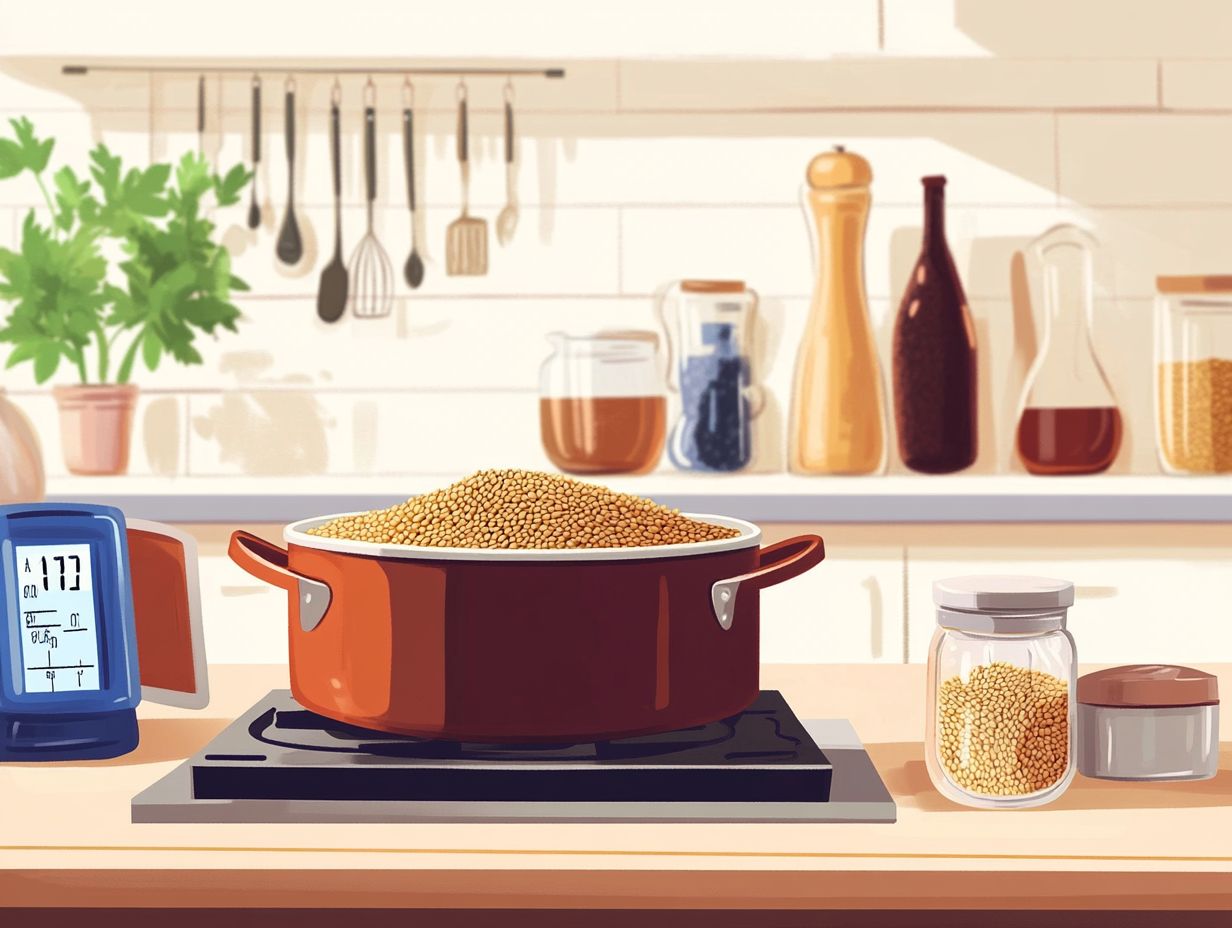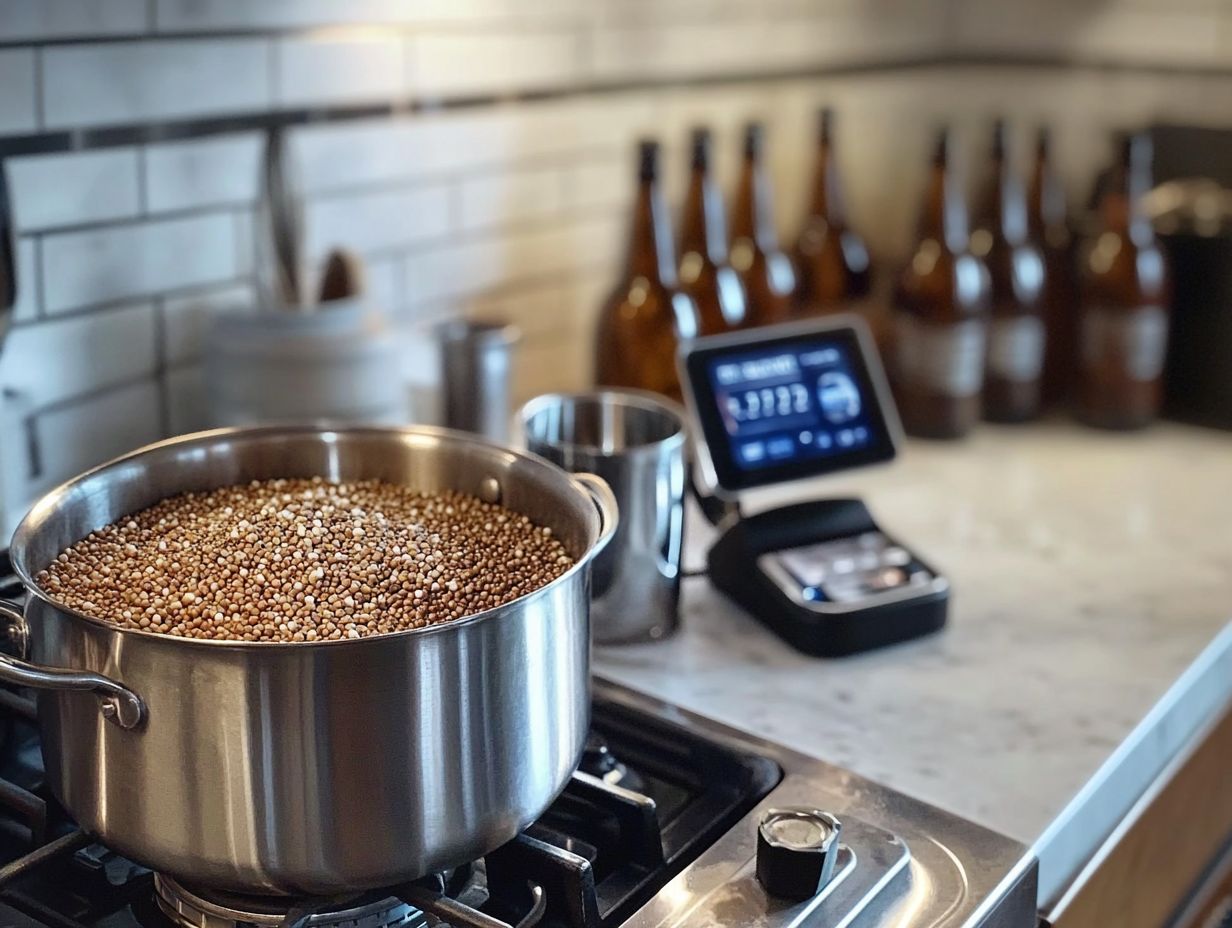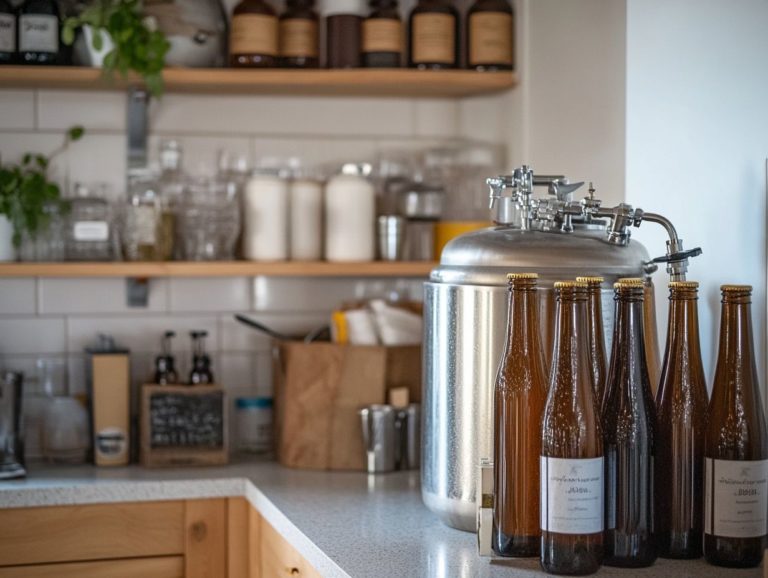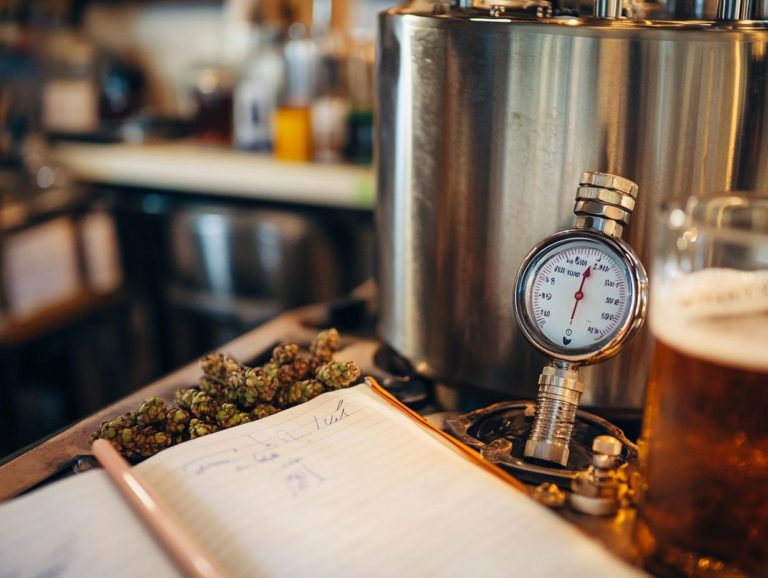The Best Cooking Methods for Home Brewing
Contents
- Home Brewing Techniques
- Key Takeaways:
- What is the Best Cooking Method for Home Brewing?
- What Are the Benefits of Using the Best Cooking Method for Home Brewing?
- What Are the Different Types of Home Brewing?
- Choosing the Best Brewing Method
- 1. Consider Your Brewing Equipment
- 2. Determine Your Brewing Goals
- 3. Experiment with Different Methods
- Frequently Asked Questions
- What are the best cooking methods for home brewing?
- Why is boiling an important cooking method for home brewing?
- How does steeping contribute to home brewing?
- What is the purpose of mashing in home brewing?
- Can I use different cooking methods for different types of home brewed beer?
- How can I determine which cooking method is best for my home brewed beer?
Home Brewing Techniques
Home brewing is an enriching craft that empowers you to craft unique and flavorful beverages right in your kitchen, using the best brewing techniques and equipment.
Selecting the appropriate cooking method can profoundly influence the quality of your homebrew.
Delve into the most effective cooking techniques, including boiling, steeping, mashing, infusion, and decoction. Discover the benefits each offers and learn how to control your brewing process with precision. This can help you avoid issues like overly estery or yeasty brews.
Familiarize yourself with various types of home brewing, such as extract brewing and all-grain brewing. Gather valuable advice on choosing the best technique to align with your brewing aspirations, whether you use brewing kits or advanced brewing equipment.
Get ready to elevate your home brewing experience like never before with tips on yeast pitching, wort cooling, and maintaining optimal mash temperature!
- Boiling is the most common and essential cooking method for home brewing, as it sanitizes the ingredients and extracts flavor from hops.
- Using the best cooking method for home brewing leads to better extraction of flavors and aromas, increased efficiency, and greater control over the brewing process. These methods can prevent issues like overly estery or too yeasty brews, ensuring a delightful final product.
- There are various types of home brewing, including extract, all-grain, and partial mash brewing, each with its own unique cooking methods and techniques.
Key Takeaways:

What is the Best Cooking Method for Home Brewing?
Determining the best cooking method for home brewing requires you to grasp the various techniques that can elevate the fermentation process. This ultimately guides you toward crafting a successful beer. Whether you re utilizing extract brewing kits or diving into more complex brewing methods, each approach plays a vital role in shaping the flavors and quality of your homebrew.
Understanding the importance of yeast pitching, wort cooling, and maintaining optimal mash temperature will also influence your results.
Techniques like boiling, steeping, and mashing each offer distinct advantages. These allow you to create an array of beer styles from a refreshing witbier to complement your witbier-marinated shrimp, to hearty brews that pair splendidly with a comforting home-cooked meal like O Davey Shepherd s Pie made with Yukon gold potatoes and ground bison.
1. Boiling
Boiling is a fundamental step in your brewing process. It is essential for extracting those rich flavors from hops while sterilizing the wort.
Knowing the significance of final gravity and alcohol by volume (ABV), which tells you how strong your beer is, during this phase can help you achieve your desired beer profile.
During this critical phase, you heat the wort to a rolling boil. This not only enhances the extraction of essential oils and bitterness from the hops but also aids in evaporating any unwanted volatile compounds.
Hops are significant players in defining your beer’s character. The timing of their addition during the boil can greatly influence the finished beverage’s bitterness and aromatic profile.
For optimal results, aim for a boil duration of at least 60 minutes. This allows for a well-rounded flavor.
By adding hops at different intervals early on for bitterness and later for aroma you can craft a balanced and complex final product.
Keeping a consistent boil is key to preventing any off-flavors, ensuring that your beer remains clean and delightful.
2. Steeping
Steeping is the art of soaking specialty grains in hot water. This crucial step in extract brewing allows you to extract exquisite flavors, vibrant colors, and enticing aromas.
This essential process elevates the complexity of your beer and introduces rich nuances that are fundamental to various styles.
When you incorporate grains like crystal malts or roasted barley, you infuse your brew with delightful sweetness, caramel undertones, and deeper color profiles. The ideal steeping temperature typically hovers between 150 F and 170 F.
You ll want to steep for about 20 to 30 minutes to strike that perfect balance drawing out the flavors without inviting any unwanted bitterness.
By mastering this technique, you position yourself to create distinctive ales and lagers. Each one showcases the unique characteristics imparted by the grains you choose.
Try incorporating culinary suggestions, like pairing your ales with home-fermented red sauerkraut or M rzen-braised bratwursts!
3. Mashing
Mashing is an essential step in the brewing process. Here, you mix crushed grains, primarily barley, with hot water.
This interaction allows enzymes to work their magic, converting starches into fermentable sugars. Monitoring mash temperature is crucial for these chemical reactions to proceed efficiently.
This process shapes the desired flavor profile of your finished beer and plays a pivotal role in the efficiency of fermentation.
Keeping an eye on the mash temperature is essential, as different temperatures activate specific enzymes that break down various types of starches.
For example, a lower mash temperature might encourage the production of fermentable sugars, resulting in a drier beer, while a higher temperature could yield more unfermentable sugars, leading to a sweeter profile.
To ensure your mashing is successful, regularly monitor the temperature and stir consistently to avoid hot spots. Allow ample time for those chemical reactions to unfold typically around 60 to 90 minutes.
This attention to detail will set you on the path to brewing excellence.
4. Infusion
Infusion is a brewing technique that invites you to elevate your craft by adding ingredients to the wort during the brewing process. This enhances and diversifies flavors in remarkable ways.
This method unlocks many possibilities. You can experiment with various infusion techniques, such as dry hopping, steeping, or cold brewing.
Imagine incorporating vibrant fruits like citrus and berries! Consider adding aromatic spices such as cinnamon and coriander, or fresh herbs like mint and basil into your creations.
Infusion can also be used in seasonal cooking, enhancing dishes like a brine bath for meats or a beer bread recipe.
Each addition not only imparts unique aromas but also influences the overall balance and character of the beer, resulting in a delightful spectrum of styles that appeal to a wide range of palates.
Ultimately, these carefully selected components become essential in crafting a memorable drinking experience, ensuring that every sip is truly special.
5. Decoction
Decoction is an advanced brewing technique that elevates your crafting game by involving the boiling of a portion of the mash. This method enhances flavor extraction and creates a richer texture in your beer.
Originating in medieval Europe, decoction has become an integral part of traditional brewing, especially in regions renowned for their lagers and bocks.
Unlike simpler infusion methods that steep all ingredients together, decoction allows you to strategically separate a portion of the mash. This gives you control over the heat, enabling the development of complex flavor layers.
The benefits of this meticulous process are reflected in the resulting beer, which often features a fuller mouthfeel and a deeper, maltier profile transforming your overall drinking experience.
The depth and richness of decoction can set your brew apart. Explore beer recipes today to enhance your brewing skills, drawing inspiration from brewing legends like Emily Hutto or breweries like Breckenridge Brewery!
What Are the Benefits of Using the Best Cooking Method for Home Brewing?

Beer Judge Certification Program
Joining programs such as the Beer Judge Certification Program can equip you with the knowledge to better understand and critique the beers you brew.
Utilizing the finest cooking methods for home brewing brings a multitude of benefits that greatly elevate the quality and flavor of your beer, paving the way for your homebrew success. By employing effective techniques such as extracting rich flavors and aromas through boiling and mashing, you gain greater control over the brewing process, resulting in a craft beer that is both delightful and distinctive. Additionally, understanding and using advanced brewing technology can further refine your homebrew.
Moreover, a solid understanding of the brewing process gives you the power to experiment with an array of beer styles, from traditional seasonal selections like Oktoberfest and M rzen-braised bratwursts to inventive recipes crafted with unique ingredients like O Davey Irish Stout.
1. Extraction of Flavors and Aromas
The extraction of flavors and aromas is essential in brewing, profoundly impacting the final taste and character of your homebrew.
Various cooking techniques act as critical catalysts in this process, with methods like steeping, boiling, and dry hopping playing pivotal roles. For example, when you steep specialty grains at just the right temperature, enzymes break down starches into fermentable sugars, all while imparting those rich, toasty notes that create a more intricate flavor profile.
Boiling hops during the brewing process not only adds bitterness to balance out sweetness but also releases essential oils that infuse your beer with floral and citrus undertones. The timing of adding different hop varieties can enhance the aroma, elevating the overall sensory experience and transforming each sip into an exploration of diverse and vibrant flavors. The use of hops varieties like Saaz, Cascade, and Fuggle can diversify your flavor profile.
2. Increased Efficiency
Increasing efficiency in your brewing process can lead to higher yields and superior quality beer, making it an essential benefit of mastering cooking methods.
When you implement time-saving techniques and optimize your equipment usage, you not only boost production speed but also maintain consistency in flavor and texture. For example, employing strategies like batch brewing and precise timing can significantly cut down on downtime between processes. With careful planning and effective resource management, you can ensure that your ingredients are utilized wisely, reducing waste and minimizing costs.
By strategically organizing your workflow and leveraging advanced brewing technology, you can create a smoother operation that ultimately enhances the excellence of your final product and elevates customer satisfaction.
3. Control over the Brewing Process
Using tools like BeerSmith for recipe management and One Step cleaner for sanitizing can further enhance your control over the brewing process.
Having control over the brewing process allows you to tailor your beers precisely to your personal preferences, resulting in truly unique homebrew creations.
This level of control not only enhances precision in fermentation but also enables you to make intentional flavor adjustments, opening the door to experimentation with a diverse range of beer styles. For example, tweaking the fermentation temperature can lead to a cleaner taste or highlight fruity esters, while adjusting the malt bill can elevate the beer s body and sweetness.
By strategically manipulating hop additions throughout the brewing stages, you can achieve that perfect balance of bitterness or introduce specific aromatic qualities that align with your vision. All these variables create an exciting avenue for creativity, ensuring that each batch reflects your intent and passion as a brewer.
What Are the Different Types of Home Brewing?
Home brewing presents an array of methods, each tailored to various skill levels and personal preferences, such as extract brewing, all-grain brewing, and partial mash brewing. Grasping these techniques not only broadens your brewing repertoire but also profoundly impacts the flavor and quality of your final creation.
For example, extract brewing is frequently chosen by newcomers for its straightforward approach. In contrast, all-grain brewing provides you with enhanced control over ingredients and the brewing process, inviting you to delve deeper into the rich world of flavors and styles.
1. Extract Brewing

Extract brewing streamlines the entire brewing process by utilizing pre-extracted sugars and malt, making it an ideal choice for both beginners and those seeking straightforward recipes.
This approach eliminates the need for extensive grain handling. This allows you to concentrate more on the art of fermentation and flavoring rather than navigating the complexities of mashing.
Typical brewing kits designed for extract brewing typically include components such as:
- Pre-hopped malt extract
- Fermentation buckets
- Basic equipment like airlocks and hydrometers
These kits equip you with all the essential tools to embark on your brewing journey without overwhelming you with unnecessary details.
By following the included instructions, you can explore various flavors by blending extracts to craft unique, personalized brews, all while showcasing your creativity as you hone your brewing skills.
2. All-Grain Brewing
All-grain brewing is an elevated approach that immerses you in the use of whole grains, granting you complete control over the mash temperature and the entire brewing process.
This hands-on involvement not only elevates the flavor profile of your beer but also deepens your understanding of the intricate science of fermentation. While the rewards are exceptional, this technique does come with its own set of challenges. These include managing the necessary equipment and mastering the detailed steps involved.
To optimize mash temperature and ensure efficient extraction, maintaining consistent heat throughout the process is essential; any fluctuations could lead to flavors you’d rather avoid.
This method opens the door to your creativity, allowing you to experiment with various grain combinations and temperatures. Ultimately, this enables you to craft unique brews that cater to specialized tastes.
3. Partial Mash Brewing
Partial mash brewing seamlessly blends the best elements of both extract and all-grain brewing, offering a hybrid approach that perfectly suits intermediate homebrewers like you.
This method strikes an excellent balance, enabling you to enjoy the convenience of malt extract while also engaging in the art of grain mashing. Mashing is the process of mixing crushed grains with water to convert starches into sugars.
With partial mash brewing, you have the freedom to choose specific grains that impart unique flavors and aromas to your final product. This results in a more personalized beer that truly reflects your individual taste preferences.
It s a sweet spot that minimizes complexity and equipment requirements compared to all-grain brewing, making it more accessible for those eager to experiment with brewing techniques. You can enhance the complexity of your beers without the overwhelming commitment that comes with a full all-grain setup.
Choosing the Best Brewing Method
Selecting the ideal cooking method for home brewing involves thoughtful consideration of your brewing equipment, your specific brewing objectives, and an adventurous spirit to experiment with various techniques.
Each method, whether it s boiling or mashing, offers distinct results. Grasping your personal preferences will guide you in crafting the perfect beer to match your palate.
For instance, if you aspire to create a rich beer brimming with complexity, you might delve into all-grain brewing techniques. Conversely, if you value simplicity, opting for extract brewing kits could be your best bet.
1. Consider Your Brewing Equipment
When you contemplate your brewing equipment, it s crucial to assess your current setup and how it aligns with your brewing ambitions. The type of equipment you choose can significantly impact fermentation efficiency, flavor extraction, and the overall quality of your beer.
For example, if you re venturing into all-grain brewing, you ll likely need a mash tun and a lauter tun to effectively convert starches. On the other hand, if you re an extract brewer, a straightforward kettle might be all you need.
The choice of fermentation vessels be it glass carboys or conical fermenters plays a pivotal role. It can influence temperature control and yeast activity, ultimately shaping the final profile of your beer.
By grasping these intricacies, you can select the right tools that elevate your unique brewing methods. This thoughtful approach supercharges your brewing experience and leads to the creation of exceptional beer.
2. Determine Your Brewing Goals
Determining your brewing goals is essential for selecting the best cooking method, as it steers you toward the flavors and beer styles you aspire to create.
Clearly defining what you want from your brewing experience empowers you to make informed decisions. These choices should align with your taste preferences and the types of beers you enjoy most.
For example, if you find yourself enchanted by hoppier IPAs or the luxurious depth of rich stouts, the methods you choose will likely diverge significantly.
Experimentation is key in this endeavor; the process of trial and error can lead to delightful surprises that refine both your palate and your brewing technique. Embrace this journey, and let your culinary creativity flourish as you explore various styles, enabling you to craft distinctive brews that truly reflect your unique tastes.
3. Experiment with Different Methods
Experimenting with various brewing methods can lead you to exciting discoveries and innovations in flavor, truly enriching your home brewing experience.
Crafting unique beers isn’t just about honoring tradition; it’s also about trying new things and exploring new horizons. Embrace the creative process and thoughtfully consider the addition of new ingredients, such as distinctive hops or specialty malts.
Keeping a detailed brewing journal can be invaluable, allowing you to document changes in your recipes and their outcomes. This practice helps you identify what works and what doesn’t, creating a safe space for refining your techniques over time.
Engaging with brewing communities can offer you valuable insights, enhancing your understanding of safe practices in experimentation while ensuring that the art of brewing remains both enjoyable and rewarding.
Frequently Asked Questions

What are the best cooking methods for home brewing?
The best cooking methods for home brewing are boiling, steeping, and mashing.
Why is boiling an important cooking method for home brewing?
Boiling is an important cooking method for home brewing because it sterilizes the ingredients, extracts flavor from the hops, and stops enzyme activity.
How does steeping contribute to home brewing?
Steeping grains in hot water releases their flavor and extracts sugars, adding a rich maltiness to home brewed beer.
What is the purpose of mashing in home brewing?
Mashing combines grains with hot water, converting starches into fermentable sugars for the beer base.
Can I use different cooking methods for different types of home brewed beer?
Yes, different cooking methods can be used for different types of home brewed beer. For example, some beers may require a longer mashing process or additional boiling time.
How can I determine which cooking method is best for my home brewed beer?
The best cooking method for your home brewed beer will depend on the style and recipe of the beer you are making. Researching and experimenting with different methods can help you find the perfect one for your beer.






